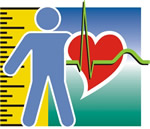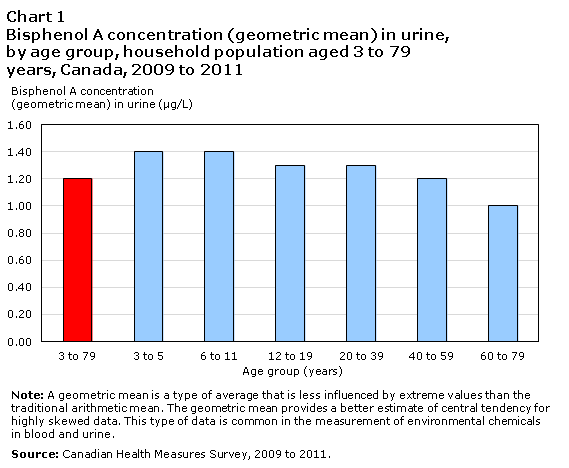Publications
Bisphenol A concentrations in Canadians, 2009 to 2011
Bisphenol A concentrations in Canadians, 2009 to 2011
Archived Content
Information identified as archived is provided for reference, research or recordkeeping purposes. It is not subject to the Government of Canada Web Standards and has not been altered or updated since it was archived. Please "contact us" to request a format other than those available.
 Bisphenol A (BPA) is an industrial chemical used to manufacture polycarbonate plastics and epoxy resins. It is primarily found in items such as repeat-use food and beverage containers and in the protective linings of food or beverage cans.Note 1 BPA is also used to manufacture items such as dental sealants, compact discs and medical devices, among others.Note 2 People are mainly exposed to BPA through dietary intake or through contact with BPA-containing items.Note 1 Some studies have suggested that BPA at low levels of exposure can affect neural development and behaviour when experimental animals are exposed in very early life. However, there is some uncertainty in interpreting how these findings might be relevant to human health.Note 3 Due to these uncertainties, the use of BPA in the manufacture of certain products, specifically those designed for use by infants, has been restricted in some countries.Note 1, Note 2 The amount of BPA exposure that may be associated with adverse health effects in humans is currently unknown. Health Canada has stated that current dietary exposure to BPA through food packaging uses is not expected to pose a health risk to the general population.Note 1, Note 2
Bisphenol A (BPA) is an industrial chemical used to manufacture polycarbonate plastics and epoxy resins. It is primarily found in items such as repeat-use food and beverage containers and in the protective linings of food or beverage cans.Note 1 BPA is also used to manufacture items such as dental sealants, compact discs and medical devices, among others.Note 2 People are mainly exposed to BPA through dietary intake or through contact with BPA-containing items.Note 1 Some studies have suggested that BPA at low levels of exposure can affect neural development and behaviour when experimental animals are exposed in very early life. However, there is some uncertainty in interpreting how these findings might be relevant to human health.Note 3 Due to these uncertainties, the use of BPA in the manufacture of certain products, specifically those designed for use by infants, has been restricted in some countries.Note 1, Note 2 The amount of BPA exposure that may be associated with adverse health effects in humans is currently unknown. Health Canada has stated that current dietary exposure to BPA through food packaging uses is not expected to pose a health risk to the general population.Note 1, Note 2Majority of Canadians have BPA in their urine
BPA is rapidly broken down in the body and excreted in urine. The BPA measured in urine is therefore thought to indicate recent BPA exposure. From 2009 to 2011, BPA was detected in the urine of 95% of Canadians aged 3 to 79 years. The average BPA concentration was 1.2 μg/L. The health effects associated with exposure at this level are currently unknown.
BPA levels do not differ by age group or sex
BPA levels decreased slightly with age, although the differences were not significant. Children aged 3 to 5 years and 6 to 11 years had the highest BPA levels with an average concentration of 1.4 μg/L, while adults aged 60 to 79 years had the lowest BPA levels (1.0 μg/L). BPA levels were the same for males and females of all age groups.
Current BPA levels did not differ from those previously found in cycle 1 of the Canadian Health Measures Survey (CHMS, 2007 to 2009).Note 4 In the 2009 to 2011 survey, BPA levels did not differ by education level, household income, or body mass index, which is also consistent with data from cycle 1 of the CHMS.Note 4
Data source
Data are from the 2009 to 2011 Canadian Health Measures Survey (CHMS). The CHMS collected data from a nationally representative sample of Canadians aged 3 to 79 years from 18 collection sites across Canada. Basic demographic and health information was collected during a household interview, followed by a series of direct physical measurements taken at a mobile examination centre. Blood and urine samples were collected from consenting respondents aged 3 to 79. The CHMS measured total BPA in urine.
References
- Health Canada. Health Canada’s updated assessment of bisphenol A (BPA) exposure from food sources. Ottawa, ON. 2012. Accessed January 21, 2012.
- Environment Canada and Health Canada. Proposed Risk Management Approach for Phenol, 4,4’-(1-methylethylidene)bis (Bisphenol A). Ottawa, ON. 2008. Accessed January 21, 2012.
- Environment Canada and Health Canada. Questions and Answers for Action on Bisphenol A Under the Chemicals Management Plan. 2010 Accessed February 28, 2013.
- Bushnik T, Haines D, Levallois P, Levesque J, Oostdam JV, Viau C. Lead and bisphenol A concentrations in the Canadian population. Health Reports (Statistics Canada, Catalogue 82-003) 2010; 21(3). Accessed March 8, 2013.
For more information on the Canadian Health Measures Survey, please contact Statistics Canada’s Statistical Information Service (toll-free 1-800-263-1136; 613-951-8116; infostats@statcan.gc.ca).
- Date modified:

